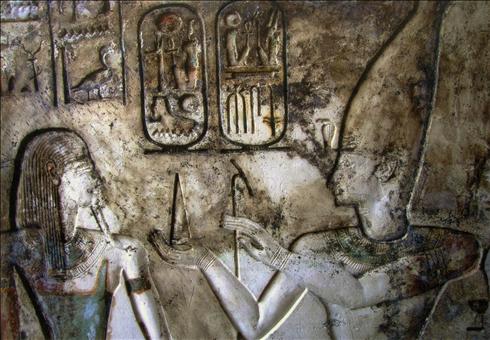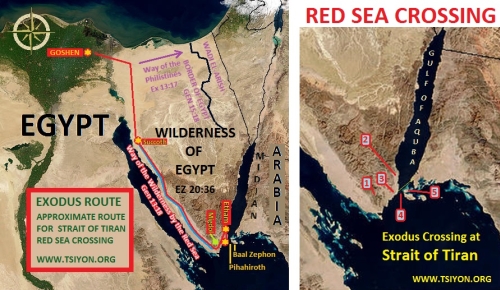 |
 |
 |
|
A handout picture released by Egypt's
Supreme Council of Antiquities on April 21,
2009 shows carvings on a wall at an ancient
temple in the Sinai peninsula. Egyptian
archaeologists have unearthed carvings at
four ancient temples in the Sinai peninsula
which they hope will shed fresh light on one
of the most obscure periods of Pharaonic
history. |
|
|
CAIRO — Archaeologists exploring an old military road in the Sinai
have unearthed four new temples amidst the 3,000-year-old remains of
an ancient fortified city that could have been used to impress
foreign delegations visiting Egypt, antiquities authorities
announced Tuesday.
Among the discoveries was the largest mud brick temple found in the
Sinai with an area of 70 by 80 meters (77 by 87 yards) and fortified
with mud walls 3 meters (10 feet) thick, said Zahi Hawass, chief of
Egypt's Supreme Council of Antiquities.
The find was made in Qantara, 2 1/2 miles (4 kilometers) east of the
Suez Canal. These temples mark the latest discovery by archaeologists
digging up the remains of the city on the military road known as "Way of
Horus." Horus is a falcon-headed god, who represented the greatest
cosmic powers for ancient Egyptians.
The path once connected Egypt to Palestine and is close to present-day
Rafah, which borders the Palestinian territory of Gaza.
Archaeologist Mohammed Abdel-Maqsoud, chief of the excavation team, said
the large brick temple could potentially rewrite the historical and
military significance of the Sinai for the ancient Egyptians.
The temple contains four hallways, three stone purification bowls and
colorful inscriptions commemorating Ramses I and II. The grandeur and
sheer size of the temple could have been used to impress armies and
visiting foreign delegations as they arrived in Egypt, authorities said.
The dig has been part of a joint project with the Culture Ministry that
started in 1986 to find fortresses along the military road. Hawass said
early studies suggested the fortified city had been Egypt's military
headquarters from the New Kingdom (1569-1081 B.C.) until the Ptolemaic
era, a period lasting about 1500 years.
In a previous find, archaeologists there reported finding the first ever
New Kingdom temple to be found in northern Sinai. Studies indicated the
temple was built on top of an 18th Dynasty fort (1569-1315 B.C.).
Last year, a collection of reliefs belonging to King Ramses II and King
Seti I (1314-1304 B.C.) were also unearthed along with rows of
warehouses used by the ancient Egyptian army during the New Kingdom era
to store wheat and weapons.
Abdel-Maqsoud said the fortified city corresponded to the inscriptions
of the Way of Horus found on the walls of the Karnak Temple in Luxor
which illustrated the features of 11 military fortresses that protected
Egypt's eastern borders. Only five of them have been discovered to date.
|











